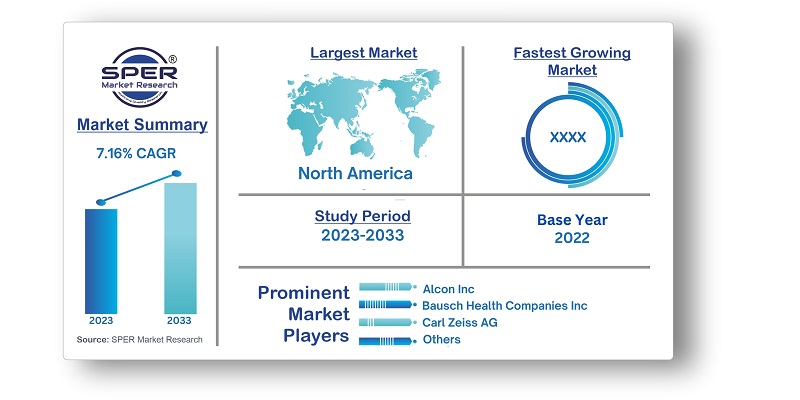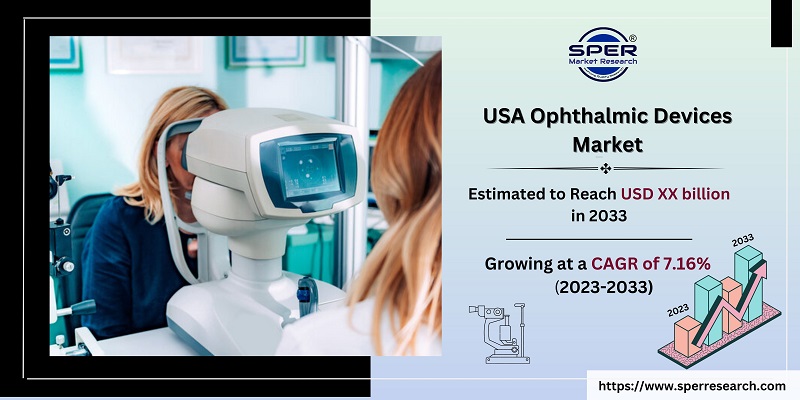
USA Ophthalmic Devices Market Growth, Size, Share, Trends, Manufacturers and Future Outlook
USA Ophthalmic Devices Market Size- By Device Type- Regional Outlook, Competitive Strategies and Segment Forecast to 2033
| Published: Apr-2023 | Report ID: MEDE2314 | Pages: 1 - 103 | Formats*: |
| Category : Medical Devices | |||


| Report Metric | Details |
| Market size available for years | 2019-2033 |
| Base year considered | 2022 |
| Forecast period | 2023-2033 |
| Segments covered | By Device Type |
| Regions covered | Eastern Region, Northern Region, Southern Region, Western Region |
| Companies Covered | Alcon Inc., Bausch Health Companies Inc., Carl Zeiss AG, EssilorLuxottica SA, HAAG-Streit Group, Hoya Corporation, Johnson and Johnson, Nidek Co. Ltd, Topcon Corporation, Ziemer Ophthalmic Systems AG |
- Healthcare providers
- Ophthalmologists
- Optometrists
- Eye care professionals
- Hospitals
- Clinic
- Pharmaceutical Industry
- USA Ophthalmic Devices Market Value Share and Forecast, By Device Type, 2023-2033
- Surgical Devices
- Diagnostic and Monitoring Devices
- Vision Correction Devices
- Eastern Region
- Northern Region
- Southern Region
- Western Region
- USA Ophthalmic Devices Market Size (FY’2023-FY’2033)
- Overview of USA Ophthalmic Devices Market
- Segmentation of USA Ophthalmic Devices Market By Device Type (Surgical Devices, Diagnostic and Monitoring Devices, Vision Correction Devices)
- Statistical Snap of USA Ophthalmic Devices Market
- Growth Analysis of USA Ophthalmic Devices Market
- Problems and Challenges in USA Ophthalmic Devices Market
- Competitive Landscape in the USA Ophthalmic Devices Market
- Impact of COVID-19 and Demonetization on USA Ophthalmic Devices Market
- Details on Recent Investment in USA Ophthalmic Devices Market
- Competitive Analysis of USA Ophthalmic Devices Market
- Key Players in the USA Ophthalmic Devices Market
- SWOT Analysis of USA Ophthalmic Devices Market
- USA Ophthalmic Devices Market Future Outlook and Projections (FY’2023-FY’2033)
- Recommendations from Analyst
1.1. Scope of the report1.2. Market segment analysis
2.1. Research data source2.1.1. Secondary Data2.1.2. Primary Data2.1.3. SPER’s internal database2.1.4. Premium insight from KOL’s2.2. Market size estimation2.2.1. Top-down and Bottom-up approach2.3. Data triangulation
4.1. Driver, Restraint, Opportunity and Challenges analysis4.1.1. Drivers4.1.2. Restraints4.1.3. Opportunities4.1.4. Challenges4.2. COVID-19 Impacts of the USA Ophthalmic Devices Market
5.1. SWOT Analysis5.1.1. Strengths5.1.2. Weaknesses5.1.3. Opportunities5.1.4. Threats5.2. PESTEL Analysis5.2.1. Political Landscape5.2.2. Economic Landscape5.2.3. Social Landscape5.2.4. Technological Landscape5.2.5. Environmental Landscape5.2.6. Legal Landscape5.3. PORTER’s Five Forces5.3.1. Bargaining power of suppliers5.3.2. Bargaining power of buyers5.3.3. Threat of Substitute5.3.4. Threat of new entrant5.3.5. Competitive rivalry5.4. Heat Map Analysis
6.1. USA Ophthalmic Devices Market Manufacturing Base Distribution, Sales Area, Product Type6.2. Mergers & Acquisitions, Partnerships, Product Launch, and Collaboration in USA Ophthalmic Devices Market
7.1. USA Ophthalmic Devices Market Value Share and Forecast, By Device Type, 2023-20337.2. Surgical Devices7.2.1. Glaucoma Drainage Devices7.2.2. Glaucoma Stents and Implants7.2.3. Intraocular Lenses7.2.4. Lasers7.2.5. Other Surgical Devices7.3. Diagnostic and Monitoring Devices7.3.1. Autorefractors and Keratometers7.3.2. Corneal Topography Systems7.3.3. Ophthalmic Ultrasound Imaging Systems7.3.4. Ophthalmoscopes7.3.5. Optical Coherence Tomography Scanners7.3.6. Other Diagnostic and Monitoring Devices7.4. Vision Correction Devices7.4.1. Spectacles7.4.2. Contact Lenses
8.1. USA Ophthalmic Devices Market Size and Market Share
9.1. USA Ophthalmic Devices Market Size and Market Share by Device Type (2019-2026)9.2. USA Ophthalmic Devices Market Size and Market Share by Device Type (2027-2033)
10.1. USA Ophthalmic Devices Market Size and Market Share by Region (2019-2026)10.2. USA Ophthalmic Devices Market Size and Market Share by Region (2027-2033)10.3. Eastern Region10.4. Northern Region10.5. Southern Region10.6. Western Region
11.1. Alcon Inc.11.1.1. Company details11.1.2. Financial outlook11.1.3. Product summary11.1.4. Recent developments11.2. Bausch Health Companies Inc.11.2.1. Company details11.2.2. Financial outlook11.2.3. Product summary11.2.4. Recent developments11.3. Carl Zeiss AG11.3.1. Company details11.3.2. Financial outlook11.3.3. Product summary11.3.4. Recent developments11.4. EssilorLuxottica SA11.4.1. Company details11.4.2. Financial outlook11.4.3. Product summary11.4.4. Recent developments11.5. HAAG-Streit Group11.5.1. Company details11.5.2. Financial outlook11.5.3. Product summary11.5.4. Recent developments11.6. Hoya Corporation11.6.1. Company details11.6.2. Financial outlook11.6.3. Product summary11.6.4. Recent developments11.7. Johnson and Johnson11.7.1. Company details11.7.2. Financial outlook11.7.3. Product summary11.7.4. Recent developments11.8. Nidek Co. Ltd11.8.1. Company details11.8.2. Financial outlook11.8.3. Product summary11.8.4. Recent developments11.9. Topcon Corporation11.9.1. Company details11.9.2. Financial outlook11.9.3. Product summary11.9.4. Recent developments11.10. Ziemer Ophthalmic Systems AG11.10.1. Company details11.10.2. Financial outlook11.10.3. Product summary11.10.4. Recent developments
SPER Market Research’s methodology uses great emphasis on primary research to ensure that the market intelligence insights are up to date, reliable and accurate. Primary interviews are done with players involved in each phase of a supply chain to analyze the market forecasting. The secondary research method is used to help you fully understand how the future markets and the spending patterns look likes.
The report is based on in-depth qualitative and quantitative analysis of the Product Market. The quantitative analysis involves the application of various projection and sampling techniques. The qualitative analysis involves primary interviews, surveys, and vendor briefings. The data gathered as a result of these processes are validated through experts opinion. Our research methodology entails an ideal mixture of primary and secondary initiatives.



Frequently Asked Questions About This Report
PLACE AN ORDER
Year End Discount
Sample Report
Pre-Purchase Inquiry
NEED CUSTOMIZATION?
Request CustomizationCALL OR EMAIL US
100% Secure Payment






Related Reports
Our Global Clients
Our data-driven insights have influenced the strategy of 200+ reputed companies across the globe.




















